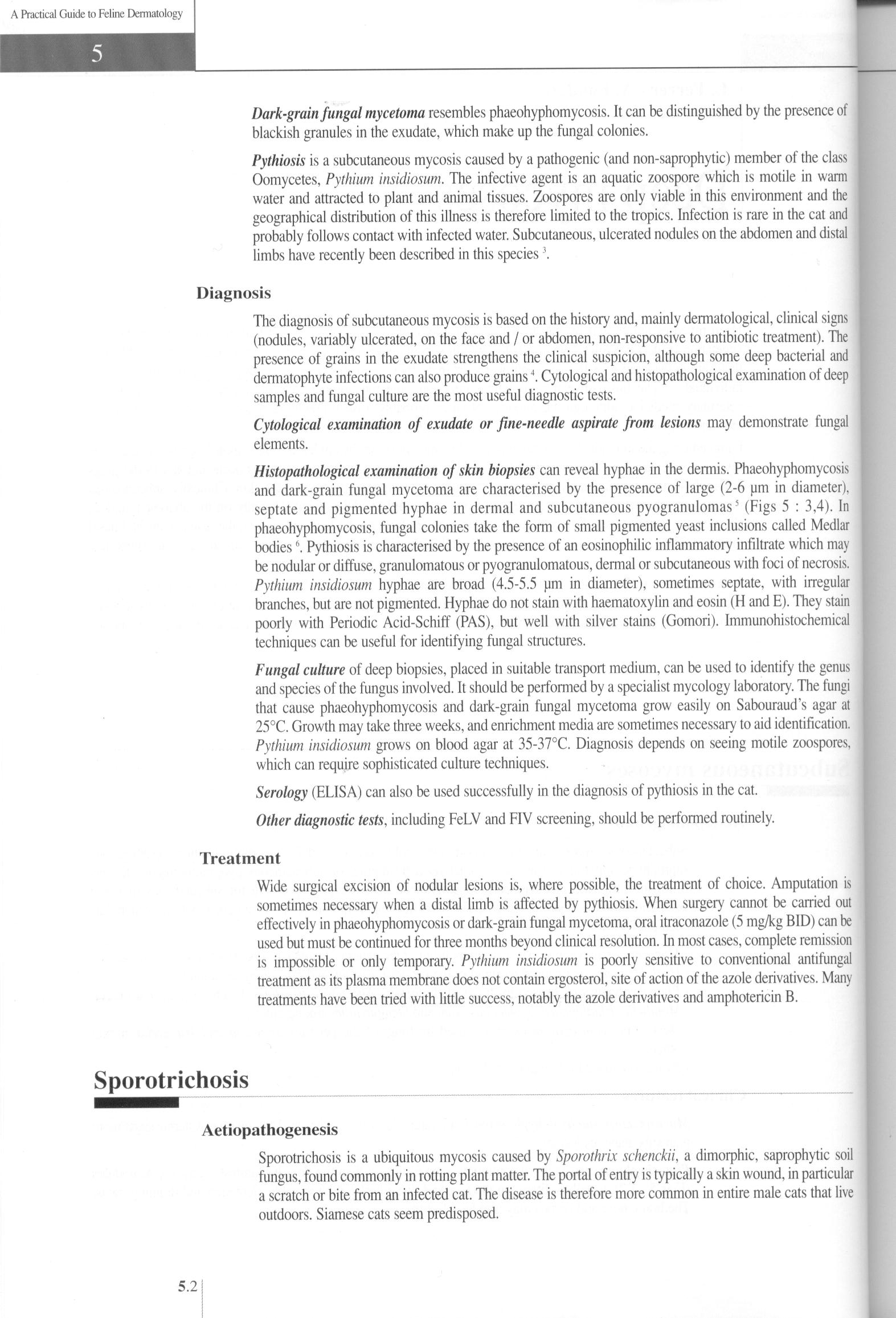52 (174)

5
A Practical Guide to Feline Dermatology
Dark-grain fungal mycetoma resembles phaeohyphomycosis. It can be distinguished by the presence of blackish granules in the exudate, which make up the fungal colonies.
Pythiosis is a subcutaneous mycosis caused by a pathogenic (and non-saprophytic) member of the class Oomycetes, Pythium insidiosum. The infective agent is an aąuatic zoospore which is motile in warm water and attracted to plant and animal tissues. Zoospores are only viable in this environment and the geographical distribution of this illness is therefore limited to the tropics. Infection is rare in the cat and probably follows contact with infected water. Subcutaneous, ulcerated nodules on the abdomen and distal limbs have recently been described in this species3.
Diagnosis
The diagnosis of subcutaneous mycosis is based on the history and, mainly dermatological, clinical signs (nodules, variably ulcerated, on the face and / or abdomen, non-responsive to antibiotic treatment). The presence of grains in the exudate strengthens the clinical suspicion, although some deep bacterial and dermatophyte infections can also produce grains4. Cytological and histopathological examination of deep samples and fungal culture are the most useful diagnostic tests.
Cytological examination of exudate or fine-needle aspirate front lesions may demonstrate fungal elements.
Histopathological examination of skin biopsies can reveal hyphae in the dermis. Phaeohyphomycosis and dark-grain fungal mycetoma are characterised by the presence of large (2-6 pm in diameter), septate and pigmented hyphae in dermal and subcutaneous pyogranulomas5 (Figs 5 : 3,4). In phaeohyphomycosis, fungal colonies take the form of smali pigmented yeast inclusions called Medlar bodies6. Pythiosis is characterised by the presence of an eosinophilic inflammatory infiltrate which may be nodular or diffuse, granulomatous or pyogranulomatous, dermal or subcutaneous with foci of necrosis. Pythium insidiosum hyphae are broad (4.5-5.5 pm in diameter), sometimes septate, with irregular branches, but are not pigmented. Hyphae do not stain with haematoxylin and eosin (H and E). They stain poorly with Periodic Acid-Schiff (PAS), but well with silver stains (Gomori). Immunohistochemical techniąues can be useful for identifying fungal structures.
Fungal culture of deep biopsies, placed in suitable transport medium, can be used to identify the genus and species of the fungus involved. It should be performed by a specialist mycology laboratory. The fungi that cause phaeohyphomycosis and dark-grain fungal mycetoma grow easily on Sabouraud’s agar at 25°C. Growth may take three weeks, and enrichment media are sometimes necessary to aid Identification. Pythium insidiosum grows on blood agar at 35-37°C. Diagnosis depends on seeing motile zoospores, which can reąuire sophisticated culture techniąues.
Serology (ELISA) can also be used successfully in the diagnosis of pythiosis in the cat.
Other diagnostic tests, including FeLV and FIV screening, should be performed routinely.
Treatment
Wide surgical excision of nodular lesions is, where possible, the treatment of choice. Amputation is sometimes necessary when a distal limb is affected by pythiosis. When surgery cannot be carried out effectively in phaeohyphomycosis or dark-grain fungal mycetoma, orał itraconazole (5 mg/kg BID) can be used but must be continued for three months beyond clinical resolution. In most cases, complete remission is impossible or only temporary. Pythium insidiosum is poorly sensitive to conventional antifungal treatment as its plasma membranę does not contain ergosterol, site of action of the azole derivatives. Many treatments have been tried with little success, notably the azole derivatives and amphotericin B.
Sporotrichosis
Aetiopathogenesis
Sporotrichosis is a ubiąuitous mycosis caused by Sporothrix schenckii, a dimorphic, saprophytic soil fungus, found commonly in rotting plant matter. The portal of entry is typically a skin wound, in particular a scratch or bite from an infected cat. The disease is therefore morę common in entire małe cats that live outdoors. Siamese cats seem predisposed.
5.2
Wyszukiwarka
Podobne podstrony:
58 (148) 5 A Practical Guide to Feline Dermatology severity of the illness. High titres are seen wit
65 (127) 6 A Practical Guide to Feline Dermatology Other topical antimicrobial agents, such as chlor
67 (125) 6 A Practical Guide to Feline DermatologyNocardiosisAetiopathogenesis Nocardiosis is a very
69 (119) 6 A Practical Guide to Feline DermatologyDiagnosis The diagnosis is based on lesion distrib
710 (2) 7 A Practical Guide to Feline DermatologyHerpesvirus infections Dermatological manifestation
74 (105) 7 A Practical Guide to Feline Dermatology ulcerated. Lesion distribution is multicentric bu
27 A Practical Guide to Feline Dermatology Perianal glands 1.7 Permethrin 3.12, 3.13 Persian 1.6,2.2
27 A Practical Guide to Feline Dermatology Stemphyllium spp. 5.1,7.8 Stereotypie behaviour 17.1,
272 (16) 27 A Practical Guide to Feline Dermatology Alternaria spp. 5.1,7.8 Aluminium hyroxide 15.6&
274 (18) 27 A Practical Guide to Feline Dermatology Colitis 11.2 Collagen 1.2,2.6,12.1,
278 (17) 27 A Practical Guide to Feline Dermatology I J Histoplasmosis 5.8, 7.8, 25.2 Homer’s syndro
28 (374) 2 A Practical Guide to Feline Dermatology Configuration of lesions Determining the configur
313 (14) A Practical Guide to Feline Dermatology The second phase consists of long-term control of t
31 (328) 3 A Practical Guide to Feline Dermatology Sarcoptic mange Sarcoptes scabiei var canis (Tabl
82 (128) 8 A Practical Guide to Feline Dermatology considered important parasites. Cats in the Unite
42 (226) 4 A Practical Guide to Feline Dermatology Increased hydration and subsequent maceration of
44 (228) 4 A Practical Guide to Feline Dermatolog) The term “asymptomatically infected cat” refers
46 (213) 4 A Practical Guide to Feline Dermatology from cats with untreated infections are often pos
48 (209) 4 A Practical Guide to Feline Dermatology Table 4:1: Type of hair invasion, fruiting bodies
więcej podobnych podstron